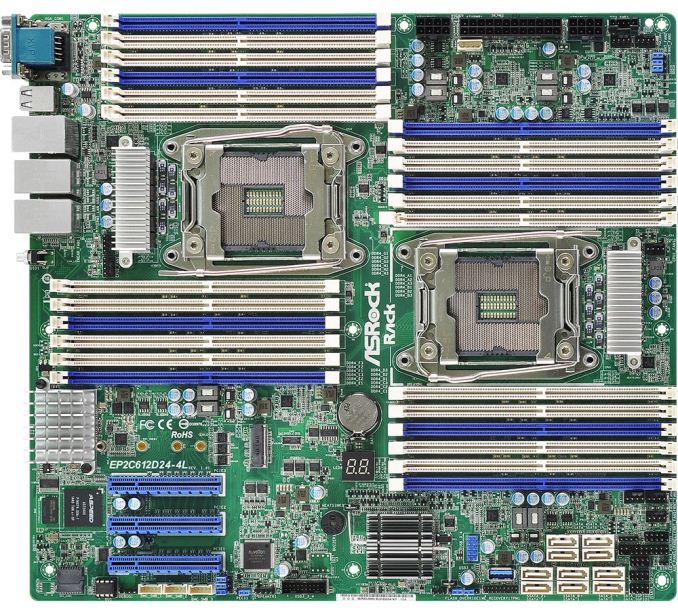ASRock Rack Announces EP2C612D24 and 4L: Dual Socket Haswell-EP with 24 DDR4 Slots
by Ian Cutress on May 23, 2015 8:10 AM EST- Posted in
- Motherboards
- Memory
- DDR4
- Enterprise
- DRAM
- Servers
- ASRock Rack
_678x452.jpg)
Two things jumped out at me when I received this press release. Firstly the name, which comes out as a mouthful – it isn’t something you could casually mention in conversation, even if you worked closely with the motherboard. The second is the amount of DRAM slots, which is ultimately what the EP2C612D24 and EP2C612D24-4L are catering for.
The Haswell-EP/Xeon E5 v3 DDR4 memory controllers are designed for up to three DIMMs per channel, similarly to Ivy Bridge-EP (E5 v2) and Sandy Bridge-EP (E5), although in all cases it is usually reserved for more niche systems. With 16GB UDIMMs, this allows for a maximum of 384GB, although moving up to RDIMM, LRDIMMs or 64GB NVDIMMs pushes the max to 1.5TB in a dual socket motherboard. Only those with deep pockets, big budgets or stringent requirements need apply, as the major cost here will be the DRAM.
The motherboard uses a staggered processor arrangement with narrow ILM versions of the LGA2011-3 socket. Combined with the 24 DRAM slots means there is little room for anything else. We get three PCIe 3.0 x8 slots which are open ended, allowing for x16 sized cards to come in, although one slot will be limited to reduced width cards as some of the DRAM slots would encroach a super long co-processor. The ten onboard SATA ports are supported by an M.2 PCIe 3.0 x4 slot and an onboard USB 3.0 Type-A port for in-chassis licensing dongles or Live-USB OSes. One downside to mention, according to the specifications for Haswell-EP, is that when fully populated, the memory should reduce down in speed, from 2133 to 1600 MHz.
Network connectivity is provided by an Intel i350 which gives four gigabit ports on the 4L model, but only two on the regular SKU, but we also get another network port for the AST2400 which provides IPMI 2.0 network management. ASRock Rack is targeting the usual suspects when it comes to large DRAM packages – intensive compute tasks, big data analysis, Hadoop and cloud computing.
Source: ASRock




_thumb.jpg)
_thumb.jpg)
_thumb.jpg)
_thumb.jpg)








48 Comments
View All Comments
Samus - Saturday, May 23, 2015 - link
SuperMicro has great support but every time I've worked on one of their server boards, I've NEEDED that support because their boards have very finicky compatibility issues due to their limited resources to validate many hardware configurations. They are, after all, a small company, and they cater to a market that often has extremely custom configurations.However, the support is so amazing, they once actually sent my configuration issue to engineering and within a week I had a CUSTOM BIOS to correct the issue I had with my Areca RAID controller not properly initializing an external 12-bay JBOD. The correction theory was to increase the voltage slope of the PCIe slot the RAID card was in to prevent a voltage drop when the JBOD was initialized. It worked.
A few months and BIOS revisions later, I was then re-notified by support that the changes I needed were validated and made it into a production BIOS and it was safe for me to flash the supported BIOS.
I don't have a lot of experience with Tyan, but SuperMicro sets a high bar.
Capissen38 - Tuesday, May 26, 2015 - link
Indeed! I had a completely identical thing happen about seven years ago while working for a big ol' whitebox integrator. The fast and personal response was nice, but good grief did we ship an uncomfortable number of servers with custom BIOSes with build dates that matched our ship dates. Once you get Supermicro systems stable, they'll run forever without issue, but it can be an adventure getting there.nils_ - Friday, May 29, 2015 - link
I had the same experience with a PCIe Infiniband card where they sent over a modified BIOS.nils_ - Friday, May 29, 2015 - link
The IPMI is utter crap however.eSyr - Saturday, May 23, 2015 - link
> it isn’t something you could casually mention in conversationBut it is perfectly memorizable — (Haswell-)EP 2-socket board with C612 chipset and 24 DDR slots == EP2C612D24.
ShieTar - Saturday, May 23, 2015 - link
I get that this board does not need a lot of Video-Connectivity, but is a VGA-Port really still the weapon of choice of Server-Admins? I'd assume that IF they want to attach a monitor to a board like this, it would be something a bit more portable than an old dusty CRT monitor.hughlle - Saturday, May 23, 2015 - link
I can't comment on its the logic but there are scores of LCD displays that take VGA..lset - Saturday, May 23, 2015 - link
Because all rack KVMs are VGA and there server adapters for any of their switches are always ethernet to usb/ps2 and VGA. Server kit like that takes ages to change and there just isn't a requirement for it to go beyond VGA.ddriver - Saturday, May 23, 2015 - link
VGA is not a CRT-only interface, all cheap, small, low res LCD displays come with VGA.sulphurlad - Sunday, May 24, 2015 - link
The Aspeed onboard iKVM has Matrox g200/g400 graphics chip. Just enough to run an OS install and not be stuck with 640x480.I wouldn't even hook up a monitor to run it, with iKVM and all, just network cables and power, login over the net and go go go.